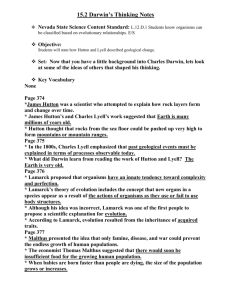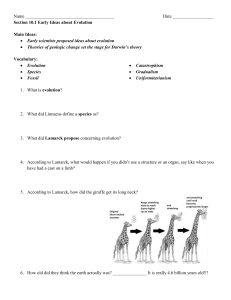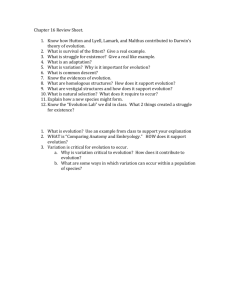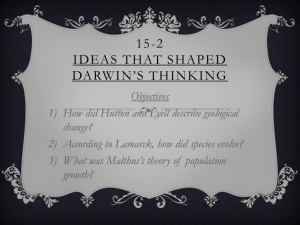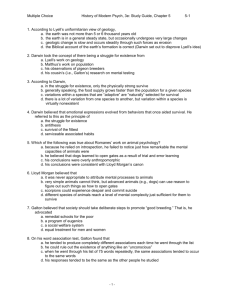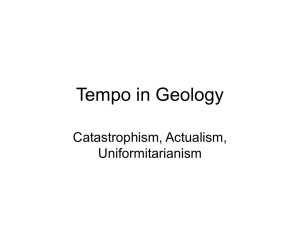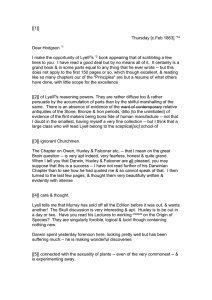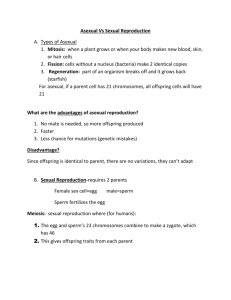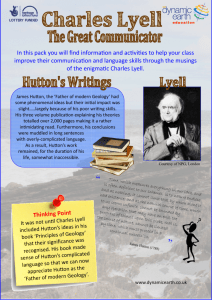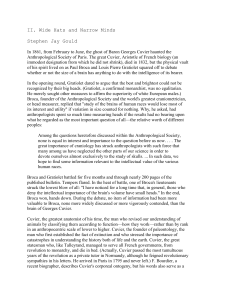Supplemental Instruction Biology 1103K Name: 8 August 2014 What
advertisement
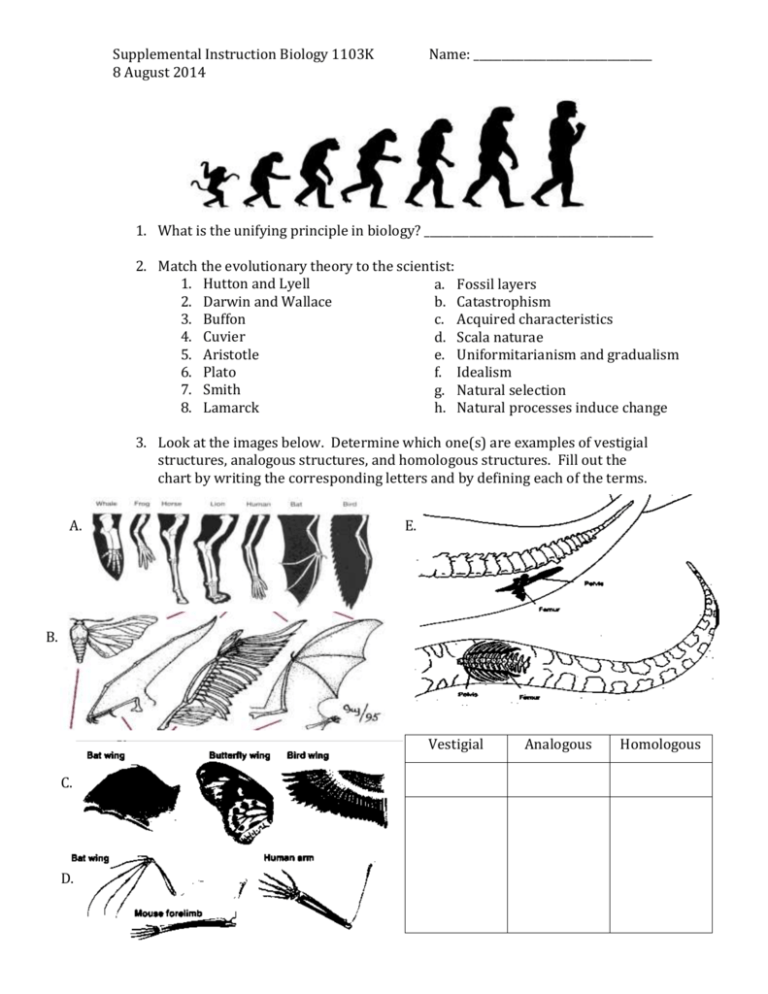
Supplemental Instruction Biology 1103K 8 August 2014 Name: ________________________________ 1. What is the unifying principle in biology? _________________________________________ 2. Match the evolutionary theory to the scientist: 1. Hutton and Lyell a. Fossil layers 2. Darwin and Wallace b. Catastrophism 3. Buffon c. Acquired characteristics 4. Cuvier d. Scala naturae 5. Aristotle e. Uniformitarianism and gradualism 6. Plato f. Idealism 7. Smith g. Natural selection 8. Lamarck h. Natural processes induce change 3. Look at the images below. Determine which one(s) are examples of vestigial structures, analogous structures, and homologous structures. Fill out the chart by writing the corresponding letters and by defining each of the terms. A. E. B. Vestigial C. D. Analogous Homologous Supplemental Instruction Biology 1103K 8 August 2014 Name: ________________________________ Evolutionary thinkers… Darwin (Source: University of Michigan) Natural Selection components : 1. Variation. Organisms (within populations) exhibit individual variation in appearance and behavior. These variations may involve body size, hair color, facial markings, voice properties, or number of offspring. On the other hand, some traits show little to no variation among individuals—for example, number of eyes in vertebrates. 2. Inheritance. Some traits are consistently passed on from parent to offspring. Such traits are heritable, whereas other traits are strongly influenced by environmental conditions and show weak heritability. 3. High rate of population growth. Most populations have more offspring each year than local resources can support leading to a struggle for resources. Each generation experiences substantial mortality. 4. Differential survival and reproduction. Individuals possessing traits well suited for the struggle for local resources will contribute more offspring to the next generation. Hutton and Lyell (Source: Baker College) Lyell (1797-1875) grew up learning the prevailing geological theory of catastrophism, which is the idea that the Earth’s features were developed through a few enormously catastrophic events. Lyell saw that the catastrophist theory was used primarily as a way to accommodate the Bible story of the Great Flood into scientific thought, so he looked to other explanations of geology. He adapted and expanded the ideas of James Hutton, an earlier geologist. The result was Lyell’s Principles of Geologyand the uniformitarian theory; instead of advocating a few drastic changes to the Earth, Lyell proposed that for the vast majority of the Earth’s history, only slow-acting processes such as sediment deposition and erosion have been agents of geological change. Cuvier (Source: UC Berkeley) Cuvier declared that they were separate species that had vanished. He later studied many other big mammal fossils and demonstrated that they too did not belong to any species alive today. The fossil evidence led him to propose that periodically the Earth went through sudden changes, each of which could wipe out a number of species. Cuvier established extinctions as a fact that any future scientific theory of life had to explain. Buffon (Source: WIkiAnswers) Buffon was able to isolate; patterns integral to a syntheses that presupposes the existence of biological evolution, whether by natural selection, the inheritance of acquired characteristics, or another solution. The patterns are: 1. Life is generated in greater profusion that can be supported over time. 2. Life is produced in great variety, variety inheritable by an organism's descendants. 3. There is relationship between similar structures in different species. Supplemental Instruction Biology 1103K 8 August 2014 Name: ________________________________ 4. Dramatically increased time is a variable offering solutions to the anomalies unexplainable by the 6,000 year old history suggested by the Bible. 5. Species have become extinct. 6. Relationships between species might be able to be discerned by conducting breeding experiments. Lamarck (Source: UC Berkeley) Lamarck was struck by the similarities of many of the animals he studied, and was impressed too by the burgeoning fossil record. It led him to argue that life was not fixed. When environments changed, organisms had to change their behavior to survive. If they began to use an organ more than they had in the past, it would increase in its lifetime. If a giraffe stretched its neck for leaves, for example, a "nervous fluid" would flow into its neck and make it longer. Its offspring would inherit the longer neck, and continued stretching would make it longer still over several generations. Meanwhile organs that organisms stopped using would shrink. Malthus (Source: UC Berkeley) Malthus’ most famous work, which he published in 1798, was An Essay on the Principle of Population as it affects the Future Improvement of Society. In it, Malthus raised doubts about whether a nation could ever reach a point where laws would no longer be required, and in which everyone lived prosperously and harmoniously. There was, he argued, a built-in agony to human existence, in that the growth of a population will always outrun its ability to feed itself. If every couple raised four children, the population could easily double in twenty-five years, and from then on, it would keep doubling. If a country’s population did explode this way, Malthus warned that there was no hope that the world’s food supply could keep up. Clearing new land for farming or improving the yields of crops might produce a bigger harvest, but it could only increase arithmetically, not geometrically. Unchecked population growth inevitably brought famine and misery. The only reason that humanity wasn’t already in perpetual famine was because its growth was continually checked by forces such as plagues, infanticide, and simply putting off marriage until middle age. Malthus argued that population growth doomed any efforts to improve the lot of the poor. Extra money would allow the poor to have more children, only hastening the nation’s appointment with famine.

